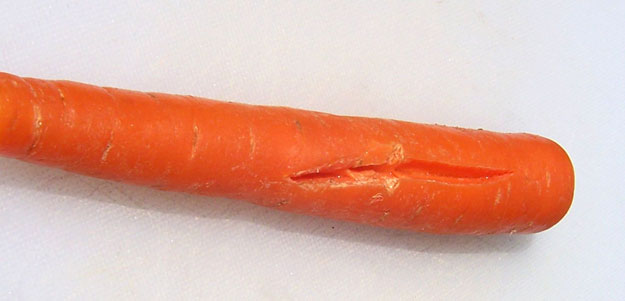You will sometimes come across carrots that show definitive cracks running the length of the carrot.

Many inspectors confuse this defect with bruising or mechanical damage, or may think these are growth cracks. But no, these are not caused by rough harvesting or due to sudden growth while in the ground. This defect is called “air cracks” or “fresh cracks.” The carrots are fine when shipped, but during transit or handling the bags during the unloading the process, the carrots actually burst, or pop open, resulting in cracks, when the carrots are moved around, more likely when they are cold and brittle. The cracks are fresh, deep and narrow and affect from 1/2 inch to almost the entire length of the carrot.
Since this defect occurs after packing, it is considered a condition defect. Once the crack develops, it will not become longer in size, nor will it become deeper. Because the flesh is exposed it is more susceptible to decay but this is not very common. It simply detracts from the appearance. The USDA does have simple scoring guidelines; score as damage when the crack is more than 20% of the length of the carrot, or more than 1/8 inch wide, or if more than 1/4 inch deep. For example, if this carrot was 7-1/2 inches long, the air crack would have to be longer than 1-1/2 inches to be scored as damage. If the crack was less than 1-1/2 inches long, but the crack was more than 1/8 inch wide, then it still would be scored as a defect.
Air cracks can be scored as damage or as serious damage, and the US Grade Standards allow a total of 10% defects, including not more than 5% for serious damage.

No Comments on “Carrots- Air Cracks”